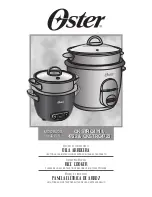
Instructions
7
EN
• If any liquid does boil over or spill,
remove the excess from the hob.
• Take care not to spill acid
substances such as lemon juice or
vinegar on the hob.
• Do not put empty pans or frying
pans on switched on cooking
zones.
• Do not use steam jets to clean the
appliance.
• Do not use rough or abrasive
materials or sharp metal scrapers.
• Do not use cleaning products
containing chlorine, ammonia or
bleach on parts made of steel or
that have metallic surface finishes
(e.g. anodizing, nickel- or
chromium-plating).
• Do not use abrasive or corrosive
detergents (e.g. scouring
powders, stain removers and
metallic sponges) on glass parts.
• Do not wash removable parts such
as the hob pan support grids,
flame-spreader crowns and
burner caps in the dishwasher.
• Never use the oven door to lever
the appliance into place when
fitting.
• Avoid exerting too much pressure
on the oven door when open.
• Do not use the handle to lift or
move the appliance.
Installation
• THIS APPLIANCE
MUST NOT BE
INSTALLED
IN BOATS OR
CARAVANS.
• The appliance must not be
installed on a pedestal.
• Position the appliance into the
cabinet cut-out with the help of a
second person.
• To avoid potential overheating, the
appliance must not be installed
behind a decorative door or a
panel.
• Have the gas connection
performed by authorised
technical personnel.
• Installation using a hose must be
carried out so that the length of
the hose does not exceed 2
metres when fully extended for
steel hoses and 1.5 metres for
rubber hoses.
• The hoses should not come into
contact with moving parts and
should not be crushed in any way.
• If required, use a pressure
regulator that complies with
current regulations.
• After carrying out any operation,
check that the tightening torque of
gas connections is between 10 Nm
and 15 Nm.






































